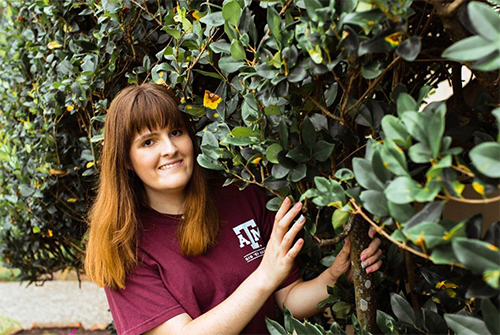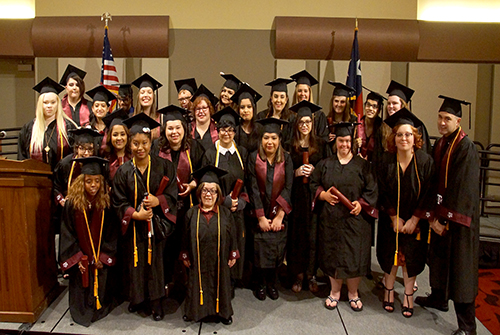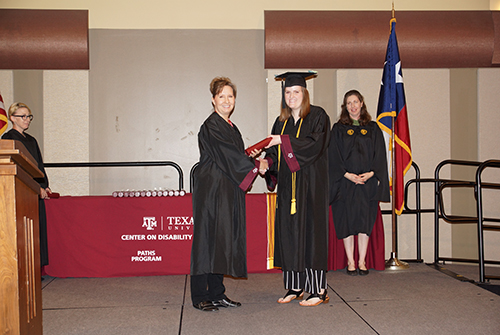 Ellie Hefner '19 recently completed the PATHS certificate program in the College of Education and Human Development. The program provides a year-long structured environment to help students, many of whom have special needs, embrace their independence so they can work in education, child care or elder care fields.
Ellie Hefner '19 recently completed the PATHS certificate program in the College of Education and Human Development. The program provides a year-long structured environment to help students, many of whom have special needs, embrace their independence so they can work in education, child care or elder care fields.
Ellie Hefner ’19 never dreamed she would attend college. However, Hefner, who has a learning disability, recently completed the Texas A&M University’s Postsecondary Access and Training in Human Services (PATHS) Program and is prepared to enter the workforce as a school district paraprofessional.
The one-year workforce training PATHS Program, which is part of the College of Education and Human Development’s Center on Disability and Development, provides a year-long structured environment to help students, many of whom have special needs, embrace their independence and earn a certificate so they can work in education, child care or elder care fields. “Our goal by the end of this program is that students will be employed and able to live on their own, call their own shots and enjoy a quality life, just like anybody else,” said PATHS Director Tracy Glass ’14. “They’re totally different people than when they started the program.”
The first of its kind in the nation, Texas A&M’s program was initially funded with a five-year grant and has become self-sufficient in the ensuing years. Some families cover the cost of their child’s program; however, many students receive financial support through the Texas Workforce Commission. “But those laws can change or organizations can change or restructure,” Glass said. Funding for social services varies in state budgets. Glass continued, "They can easily say, ‘We’re not going to provide funds for that anymore.’ That would leave a lot of students without a workforce training option after high school.”
To ensure the program’s viability, the PATHS staff are identifying numerous ways to diversify the program’s financial support. For example, Glass plans to develop the program into a comprehensive training program that will qualify to receive federal funds. In addition, she is working with the Texas A&M Foundation to create fundraising options to support the program.
An Avenue for Success
The PATHS Program annually serves approximately 25 to 30 non-traditional students who come from across Texas. “We don’t look at reading scores or writing scores. We don’t take SAT or ACT scores or IQ scores,” Glass said. “Our program is built for students for whom a four-year traditional degree-seeking program is not appropriate or not possible. We make attending workforce training courses in a college-like environment possible for students with disabilities who traditionally have had very limited options. We look for individuals who have a heart for service and would fit well with the service-oriented career training we offer.”
The program currently offers three professional tracks:
-
A direct support professional general track, which is designed for students who want to work with the elderly in nursing homes, assisted living facilities and hospice units.
-
A paraprofessional track, which prepares students to work in a school district.
-
A child care professional track, which teaches students to work in preschool and early childhood settings.
In addition, Glass and her staff are considering offering new certification tracks in horticulture and vet-tech in the future for individuals who would prefer to work with plants or animals.
 The PATHS program is opening doors for these students. After completing a summer program in which they explore topics such as professionalism, self-determination, budgeting, time management, and healthy food choices and cooking, students take two semesters of additional coursework.
The PATHS program is opening doors for these students. After completing a summer program in which they explore topics such as professionalism, self-determination, budgeting, time management, and healthy food choices and cooking, students take two semesters of additional coursework.
Bridging to the Future
The PATHS Program begins with a summer prerequisite, the Bridge to Career Program, which immerses students into coursework, Texas A&M and the Bryan-College Station area. This intensive program is designed to help the student and PATHS staff determine whether the PATHS Program aligns with a student’s goals.
The Bridge to Career Program requires students to live on campus and be engaged in sessions and activities from 7 a.m. to 8:30 p.m. during the week. Students explore topics such as professionalism, self-determination, budgeting, time management, healthy food choices and cooking, healthy relationships, and study skills. The students also begin to learn assistive technology that can help them overcome learning barriers they face.
A key part of the program involves teaching students independent living skills, including navigating Texas A&M’s campus and using the Texas A&M and Brazos Transit District bus systems. “One of the big problems that our students struggle with is traveling,” Glass said. “In the summer, we house them on campus, but in the fall and spring, they’re required to live in off-campus dorms so they can work on their independent living skills. They need to know which bus route will take them to the store.”
Following the PATH
After successfully completing the summer program, students take two semesters of additional coursework that is designed to give them the decision-making skills and tools to navigate their personal and work lives. “Many times, especially with this population, they’ve always had somebody make decisions for them,” Glass said. “We place an emphasis on person-centered planning. It’s not what their family wants; it’s not what the counselor wants. It’s what the student wants.”
During the fall semester, students take classes four days per week. While much of the coursework aligns with their professional track, additional courses focus on professionalism and healthy relationships. Students attend a weekly meeting with instructional assistants as well as trainings in areas such as person-centered practices, CPR/first aid, communication and benefits counseling. They also spend one day volunteering in their chosen area of study. “They’re getting their feet wet by seeing what it’s like in the real world,” Glass said.
The spring semester requires students to spend one day in class and four days working in their chosen area of study. This schedule gives students hands-on experience so they can practice what they learn in the classroom. Students in the PATHS Program can be found in area schools, assisted living facilities, nursing homes, hospices and daycare centers.
 Ellie Hefner '19 receives her PATHS certificate from Tracy Glass '14, the program's director.
Ellie Hefner '19 receives her PATHS certificate from Tracy Glass '14, the program's director.
Finding Their Voice and Independence
A critical part of the PATHS Program involves encouraging students to advocate for themselves. “For many of our students, that’s a very hard thing to do,” Glass said. “The power has never been in their hands like that before. They’re hesitant, but we train them that they have to speak up.”
Hefner experienced the power of self-advocacy when she and her classmates learned that a Brazos Valley Transit’s bus route that they depended on to get to work was slated for termination. “We wrote letters to the Brazos Valley Transit and let them know how much the bus route meant to us. Because of all the letters we sent, they decided to hold a public hearing. We were able to come out and talk to them,” the Montgomery, Texas native said. “I spoke at the hearing on behalf of my classmates about why we didn’t want this bus to go. They were impressed by all of our riding, but due to financial reasons, they had to cancel the bus route. Still, our voices were heard.”
The students also learn to live an independent life, something that their parents often never dreamed was possible. “People think that because your child has a disability, they can’t do certain things,” said Peggy Elder, whose son, Terence ’18, completed the PATHS Program in 2018 and is now working as a paraprofessional in Spring ISD. “They can do whatever they want to do. It’s just going to be at their own skill level and their own ability level. They really mature and become young, productive adults once they complete the PATHS Program.”
Elder is especially proud of how Terence blossomed while at Texas A&M. “He enjoyed living on his own. He and his peers went out and did things on the weekends. They took Uber rides to the movies, and they went out to the mall, restaurants and Aggie football games. They did all kinds of activities,” added Elder, who is a Spring ISD special education teacher and Lone Star College adjunct professor. “The PATHS Program teaches them to not only be independent, but to also have social skills. Go out with your friends and have a good time, but make sure your work is done first.”
Ultimately, the program opens possibilities for individuals to continue their education after high school in a classroom environment in a rich campus environment. “Two years ago, I didn’t think I could do something like this,” Hefner said. “Now, I know that if you put your heart and mind into it, you can accomplish your goals.”
To learn how you can support the PATHS Program, contact Jody Ford ’99, senior director of development, at jford@txamfoundation.com or (979) 847-8655.